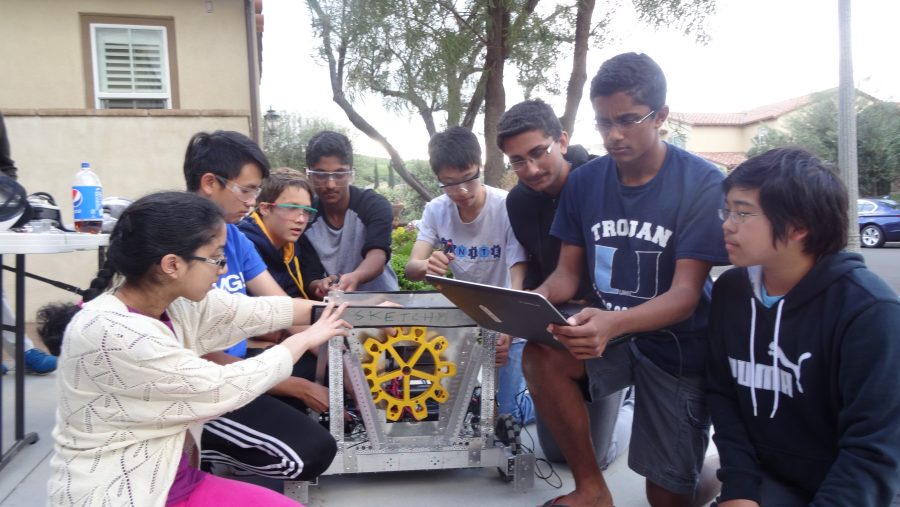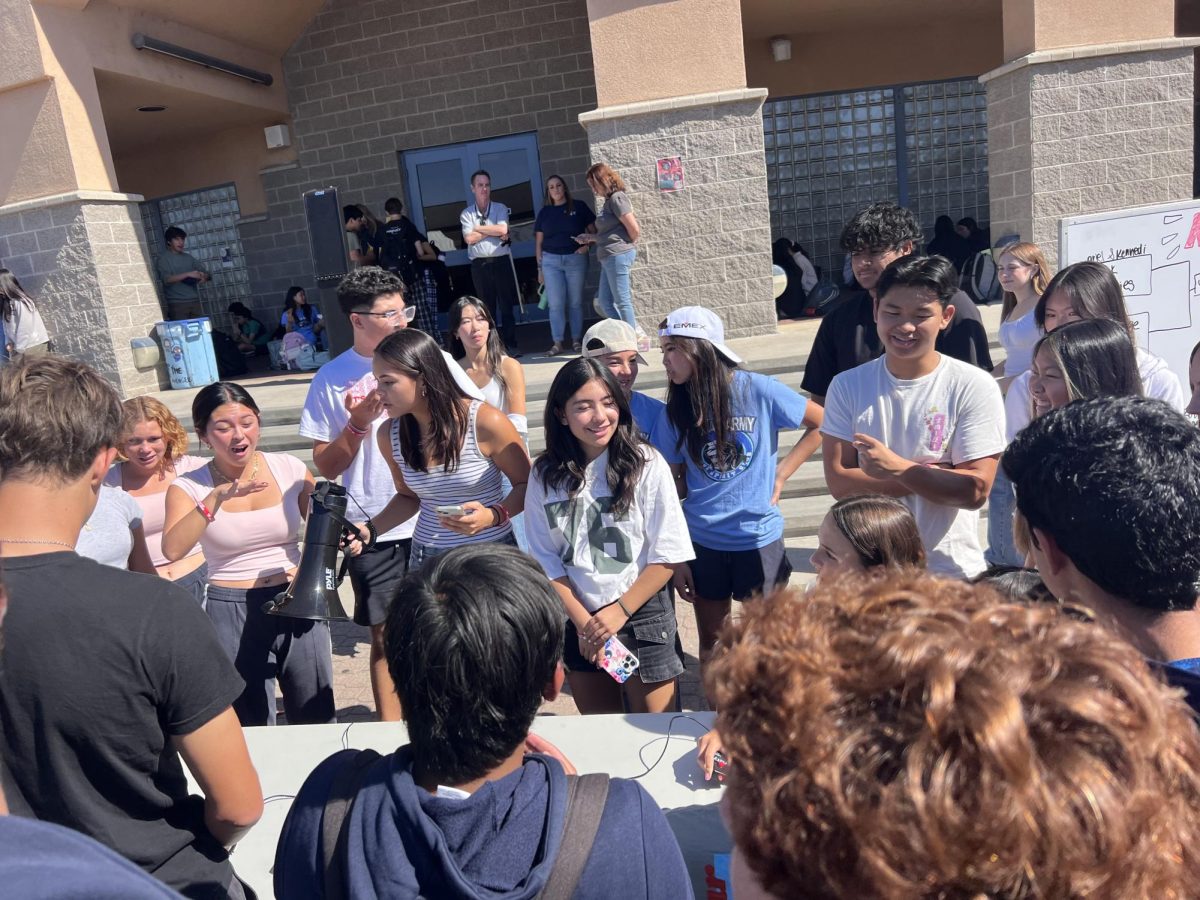By SABRINA HUANG
Staff Writer

The robotics team Charging Champions recently clinched a victory at regionals in FIRST Robotics Competition (FRC) to progress to the World Championships for the second time in the team’s history. UHS students Anish Neervannan (Jr.), Rithick Lingineni (Jr.), Pallavi Kolli (Jr.), Albert Lin (So.), Charlie Gooding (So.), David Kurniawan (So.), Arjun Neervannan (Fr.) and Yiming Jia (Fr.) will be among the twenty-one members of the Irvine-wide robotics team to represent the team at Worlds, which will take place in the last weeks of April.
The Charging Champions placed fourth overall out of 42 teams that competed at the regionals competition held in Ventura from March 16 to March 18. Because this was the first year the team decided to compete in FRC, it was also awarded the Rookie All Star Award and Highest Rookie Seed Award for their performance.
For members of the Charging Champions, this competition was further evidence of their ability and skill as a team, despite this being their first year of competing in FRC.
“I think it was pretty cool since we were a rookie team and people usually think that rookie teams don’t perform that well,” Engineering Notebook Lead and member of Robot Build team Lingineni said. “And as [we progressed] through the competition, the judges came up and said, ‘Wow, you guys really don’t seem like a rookie team [because] you’re performing really well.’”
“It kind of felt like we were underdogs because we were the rookie team and we somehow made it to the fourth place,” Robot Built Lead Neervannan (Fr.) said.
The Charging Champions competed in 11 qualifying matches in order to move on to the final rounds over the span of the three-day tournament. The team was able to progress to the playoff rounds, but were booted out in the semi-finals.
At the tournament, competing teams are randomly placed into so-called “alliances,” in which they compete with two other teams to progressively gain higher rankings. Alliances are changed for each round.
“Alliances compete against each other in three vs. three matches on fields that are the size of basketball courts,” Team Captain Neervannan (Jr.) said. “After all of the qualifying rounds have [finished], the top 8 teams can pick two other teams to join their alliance and enter the playoff rounds.”
Each year, competing robotics teams must construct a functioning robot to complete a certain challenge or set of tasks that are released at the start of the robotics season in January. This year’s theme was Steamworks.
“Each season, [FRC presents] to you a new mission or task that’s different from previous seasons, sometimes similar in style or just in general manipulation of what you have to achieve but [different in field setup],” Robot Build and Design Team member Lin said. “[It’s basically] a different task altogether that you have to do.
“This year, robots can score points by transporting a gear from one side of the field to the other, where a human player collects it and uses it to activate a rotor, scoring wiffle balls into a 10-ft tall chamber, and climbing a 5-foot rope in less than 30 seconds,” Neervannan (Jr.) said. “Even though the missions might seem somewhat simplistic, they become much more challenging and interesting when one considers the rules, restrictions and limited time.”
Though the robotics season officially started in January, the Charging Champions began work in the beginning of the school year in August.
“It took us seven months [to build both pre-season robots and robots for the competition] because we had to come up with an idea to fit this year’s challenge and we all had different ideas [so] we collaborated to see which one we wanted to select,” Community Outreach Team member Kolli said.
The actual building period lasted for a span of six weeks, in which the team built the main body of their robot to be used for competing.
“Teams can work on their robot from January 7 till February 22,” Neervannan (Fr.) said. “After that, they have to pack up their robot in a bag and seal it up, and are only allowed to access it during competitions. We actually built two robots, one of which was a backup robot that we worked on outside of the six-week build period but wasn’t actually used in any of the competitions.”
“I think we spent perhaps maybe four weeks building the main chassis of the robot,” Lin said. “This includes designing it, coming up with the mechanisms for accomplishing tasks and in four weeks we pretty much had a basic functioning prototype of the robot that we would use in season. And for the remaining of the two weeks we had for the season, we were coming up with other improvements and testing it out and then upgrading what we had. We did, of course, have a seven month period in total, but not for just this season.”
Each week, members of the Charging Champions held multiple practice and training sessions at the coach’s garage, where necessary supplies for constructing the robots were placed. Here, members dedicate numerous hours per week to training for competitions and working on any necessary improvements for their robots.
“So each week we spend around maybe 22 hours [working with one another],” Lin said. “We have four hours on Friday evenings and then we have [eight to nine hours] for both Saturday and Sunday from morning to afternoon to evening. Most members will stay for the entirety of the meeting.”
However, the team is not focused on just robotics; members are divided into multiple committees that are responsible for carrying out different tasks like fundraising or outreaching to the community that are fundamental to the proper management of the team.
“This competition isn’t [only] about robots,” Lingineni said. “There are many different soft skills that come into this challenge. We have team[s] that works on our business plan, on fundraising and many different aspects [and] I feel like FRC is more than just robotics. It’s like basically everything. It’s a job for us.”
“I have learned many hard skills such as mechanical design, CAD, and machining, but I have [also] learned soft skills like communication and teamwork,” Neervannan (Fr.) said. “And while the hard skills are useful, I personally use the soft skills more often. I often use my teamwork and collaboration skills in group projects and other presentations, and have found [the team] to also help me develop as a team player and team leader.”
With so much time spent together working on different challenges, members of the Charging Champions have become almost like a family.
“What I most enjoy about our team is the camaraderie,” Neervannan (Jr.) said. “Having spent hundreds of hours working in our garage, dealing with high pressure situation on the competition field, going wild from the stands and jumping into the pool in our team clothes after long competition days, our team has become like a second family.”
“We keep a good environment and attitude while maintaining our focus on the tasks at hand,” Robot Build and Design Teams member Kurniawan said. “The team itself is diverse with students from all over IUSD. This melting pot offers opportunities for people to forge good relationships and friendly bonds.”
“Personally, I really enjoy the culture of our team and of FRC,” Neervannan (Fr.) said. “I don’t really look at FRC as work; I see it more as something I do as a hobby. And I think that’s what really embodies the culture of our team and also of FRC. It’s not just about the robots; it’s about learning and having fun through the process.”
Charging Champions was founded five years ago by students Anish Neervannan (Jr.) and Arjun Neervannan (Fr.) and their father Raj Neervannan. Though they competed in FIRST Lego League (FLL) when the team was initially established, the Charging Champions proceeded to compete in FIRST Tech Challenge (FTC) in 2014, where they were able to qualify for the Super-Regionals competition. In 2016, the team was one of four robotics team competing in FTC in Southern California to qualify for the World Championship.
Despite starting out with an initial six members, the Charging Champions grew to a team of 21 members after recruitment efforts across schools in Irvine and subsequent interview processes. Currently, eight of those members are students from UHS.
With the World Championship less than a week away, members of the Charging Champions look forward to competing at Worlds.
“Progressing to worlds, I feel pretty excited because being in these competitions are really fun,” Lin, who will be going to the World Championship for the first time, said. “It’s a fun experience to be in even though it’s stressful and being able to experience it with a team that I’ve worked with a lot just makes all [of] our work pay off.”
“Even if we lose, even if we win, it’s still part of the game and we worked our hardest throughout the season,” Lingineni said. “There are not many times that you’ll be able to participate in a world-wide robotics competition and this is what we’ve been offered with and I feel like this is a really good experience.”
The World Championship will be held in Houston, Texas, from April 19 to April 22.
Categories:
Robotics Team advances to the World Robotics Championships
April 18, 2017
0
Tags:
Donate to Sword & Shield
$180
$1000
Contributed
Our Goal
Your donation will support the student journalists of University High School. Your contribution will allow us to purchase equipment and cover our annual website hosting costs.






![“The amazing science club, unite[s] to experiment new ways to grow their knowledge” Miles Hexun said.](https://uhsswordandshield.com/wp-content/uploads/2024/11/IMG_5875-e1731965934409-1200x723.jpg)


